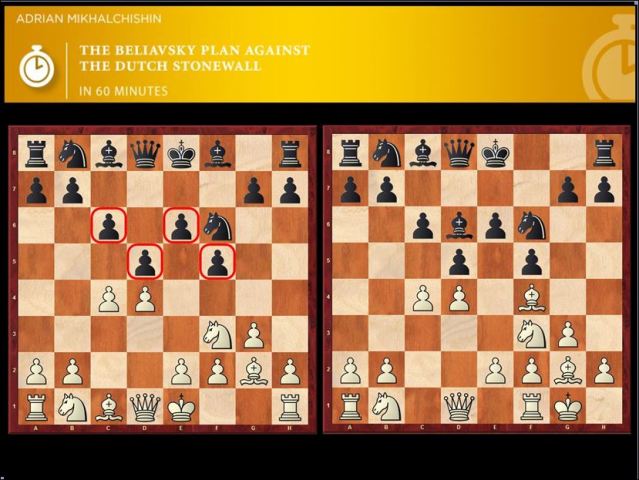


It all started on a Thursday morning, around 5:30 am, when a Facebook friend messaged me with: "Did you see the latest plan against the Stonewall Dutch?" He meant the latest video course made by Mikhalchishin with the Beliavsky plan.
I played the Classical Dutch thanks to one of the endless Simon Williams' books, and I also learned the Stonewall Dutch thanks to L'Ami. As always happens in competitive chess I was traumatized by something which happened to me in a tournament. About a year or a little more ago, I was playing 1.d4 and a player with a rating lower than mine played the Stonewall Dutch, and drew, causing me some grief! After all who doesn't love to be defined by a number — like the rating — going down? Ugh.
Since I play most of the time in the same geographic area, I tend to meet the same players over and over. When this happens, I want to be prepared for their openings. In this case, I'd like to know a simple way to neutralize the Stonewall Dutch. Mikhalchishin in his infinite wisdom as coach taught me just that!
This set of lessons is part of the "60 minutes" series of videos, which tries to teach you an opening or idea through a brief video course which well applies to modern times, with all the requisite rush!
Mikhalchishin mentions at the outset an important truth about the Stonewall, the idea of creating a pawn wall on the white squares.
How do we fight against such pawn wall? There is a weakness on e5, which often is difficult to exploit due to the general nature of the position — it's closed. This means we need to learn the plans and the strategical ideas one should have in this position. Mikhalchishin proposes a very interesting plan. He received this idea from Beliavsky, a top chess player of the 1980s.
The first game is in fact by Beliavsky and is commented by Mikhalchishin. The main tabiya of this opening, which thanks to the ChessBase training system can be played also within this article is the following:
After the moves: 1.d4 f5 2.c4 Nf6 3.g3 e6 4.Bg2 d5 5.Nf3 c6 6.0-0 Bd6 the move to play, according to Mikhachishin is 7.Bf4
You can play this position right on the diagram against an engine!
Mikhalchishin shows more about the plans at the end of a line. In this way one can try against the engine, and see the result. Why it is important to try? Because one can get a feeling for the position, and discover how an opponent could react in a tournament game.
In the following position White gave up a pawn for a strong initiative, Mikhalchishin gave two plans, I'll consider only the first, the one opening the center with Pf3 and Pe4. White now should play Ne5, and then try to realize the plan just mentioned. Try it against the engine:
The DVD is made up of eight videos. Everyone can find one hour of time, to learn these important ideas. The database of games complement the videos and, like a book, gives enough material to study. For an adult learner this is the best opportunity to learn, because between family, work, and all the rest, it is difficult to find time to spare.
While it is important to play the positions ourselves and get a feeling, it is also important to see GM games, which can give us the main ideas. In my Megabase 2018 there are more than 600 games with the line suggested by Mikhalchishin. I selected five which I thought could be pleasant, and show some of the main themes. However, the video course comes with a database of additional games — 49 in total — which are annotated by Mikhalchishin. Studying them we can gain useful insight to see if we understood the ideas given by Mikhalchishin in the videos.
It is worth to listen to Mikhalchishin because of the extremely professional way he approaches the topic. He touches the most important points: weak square on e5, pawn structures (for example the Rubinstein one, which he treated also in another DVD), and many others. This gives us a feedback on what our strengths and weaknesses are. If I don't know how to exploit the weak e5-square, clearly I need to dedicate time to learn it. Thanks to Mikhalchishin, I can fix some of my weaknesses, and improve for the next tournament, not only in opening phase but also in the middlegame. 60 minutes of Mikhalchishin can mean 10-15 hours of study and improvement, definitely worth it, especially for those on the road to mastery! Good luck to everyone!